Hochauflösende Spektroskopie ist eine vielseitig anwendbare Methode um planetare Atmosphären zu untersuchen. Vollständig aufgelöste Moleküllinien ermöglichen die Bestimmung physikalischer Parameter wie Temperatur, Anzahldichte oder Windgeschwindigkeiten. Dazu wird eine spektrale Auflösung von ca. 105 benötigt. Die zu beobachtenden Moleküle sind auch in der Erdatmosphäre vorhanden und beeinträchtigen die Qualität erdgebundener Messungen auf anderen Planeten. Die hohe Auflösung ermöglicht es aber durch transparentere Teilbereichen des Spektrums zu „spinksen“ und damit bessere Ergebnisse zu erzielen.
The Cologne-based receiver THIS (Tuneable Heterodyne Infrared Spectrometer) is the only tuneable heterodyne infrared spectrometer for application to astronomy offering access to the 7–17 µm wavelength region at a resolution of up to 3 *10^7 and a bandwidth of 3 GHz (Sonnabend et al., 2008 ) (Fig.THIS). The second Cologne instrument iCHIPS (Infrared Compact Heterodyne Instrument for Planetary Science) has a similar characteristic and is the follow-up instrument used for instrumental development and Earth applications (Stangier et al., 2013). Both instruments have been developed and are based at the I.Physikalisches Institut at the University of Cologne. They are transportable and can be used at any infrared telescope. Over the last years we frequently used the McMath-Pierce-Solar Telescope on Kitt Peak, Arizona, USA and the NASA IRTF on Mauna Kea, Hawaii, USA to address our main scientific topics.
One key application for IR heterodyne spectroscopy is the study of dynamical processes in planetary atmospheres. On Mars and Venus non-LTE processes lead to an enhanced mesospheric emission from CO2 molecules in the 10 µm band.
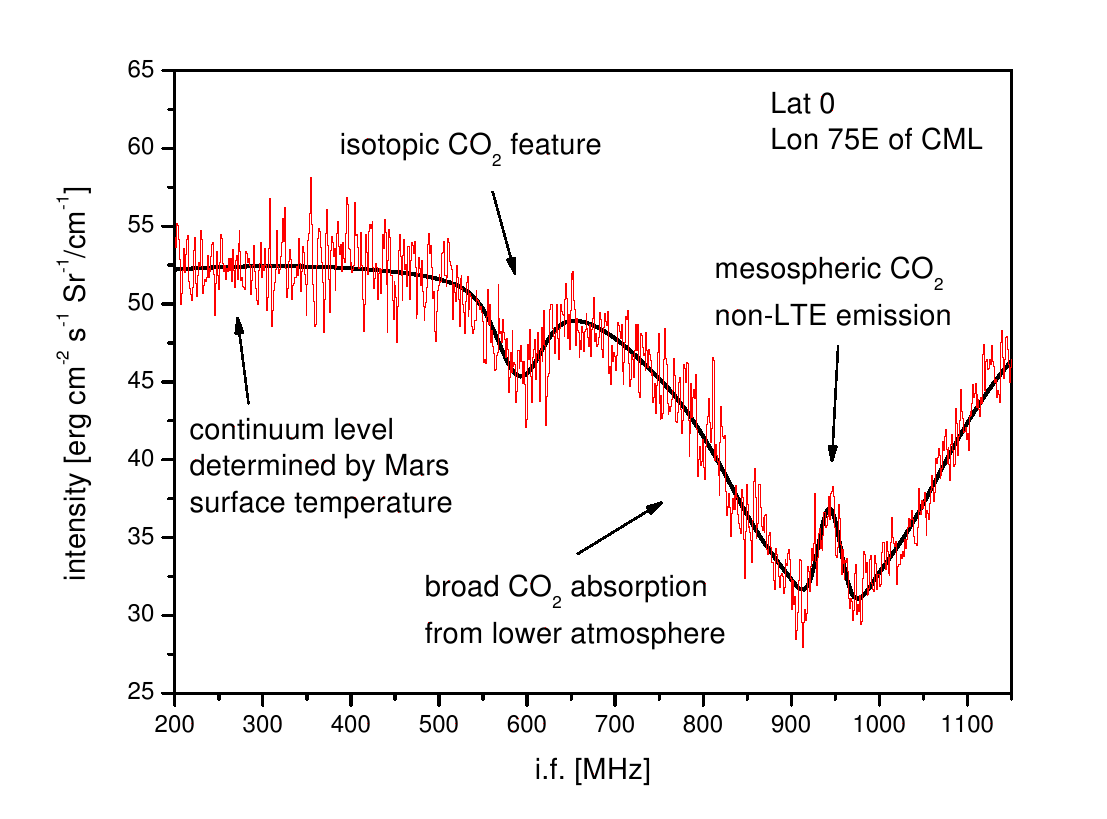
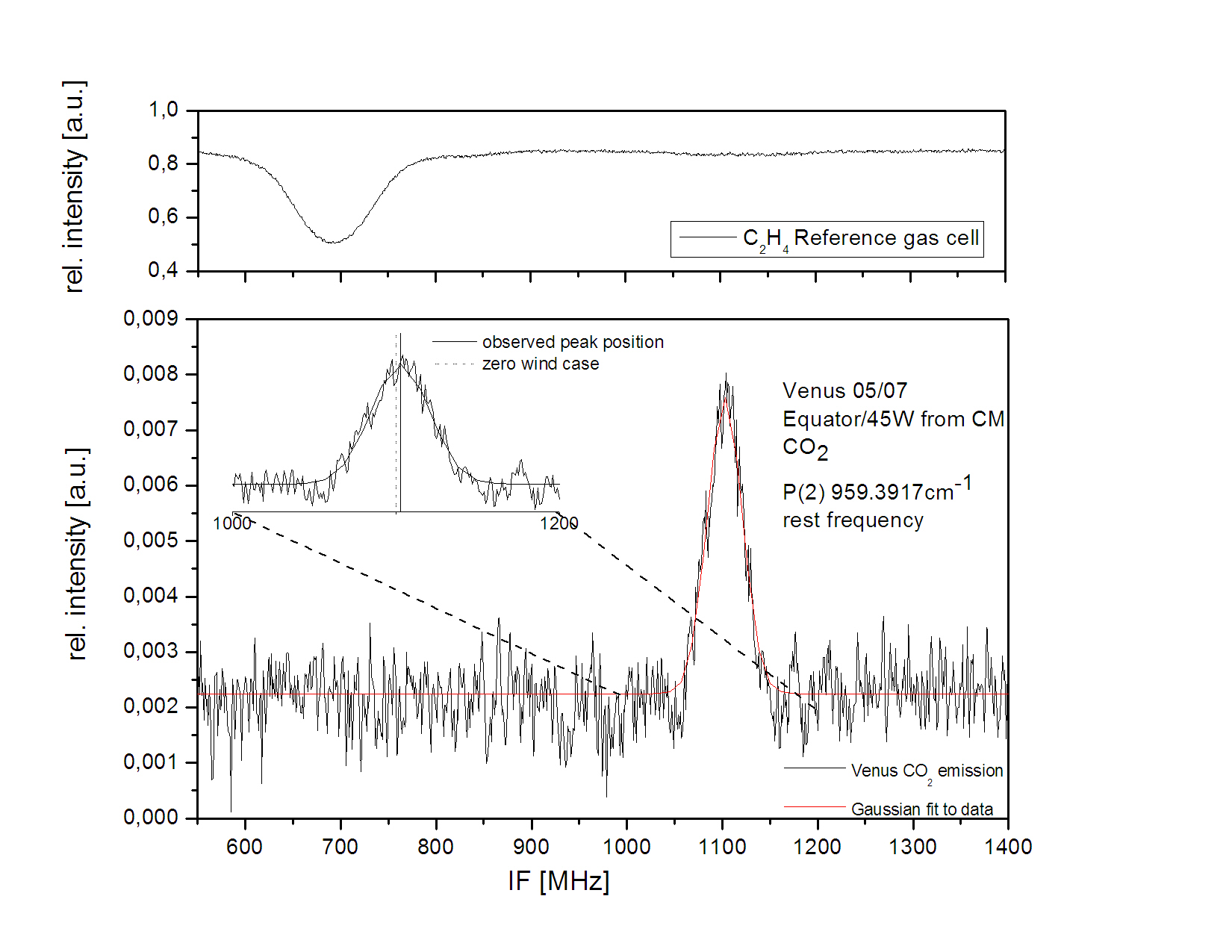
Dopplerverschobene non-LTE CO2 Emissionlinien können zur Bestimmung von Windgeschwindigkeiten verwendet werden. Die Frequenzverschiebung kann direkt in einen „Sichtlinienwind“, mit einer Genauigkeit von bis zu 10 m/s, konvertiert werden.
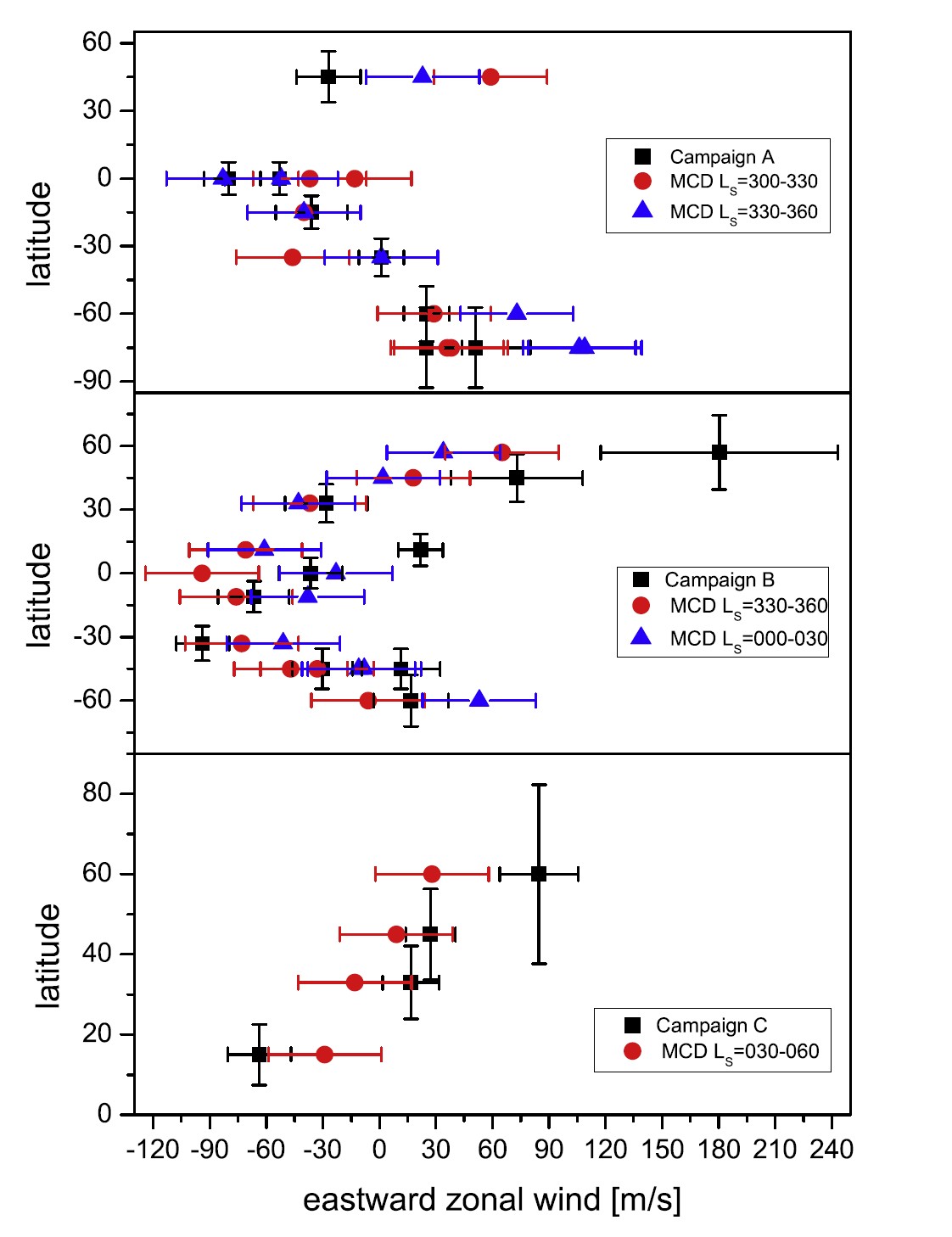
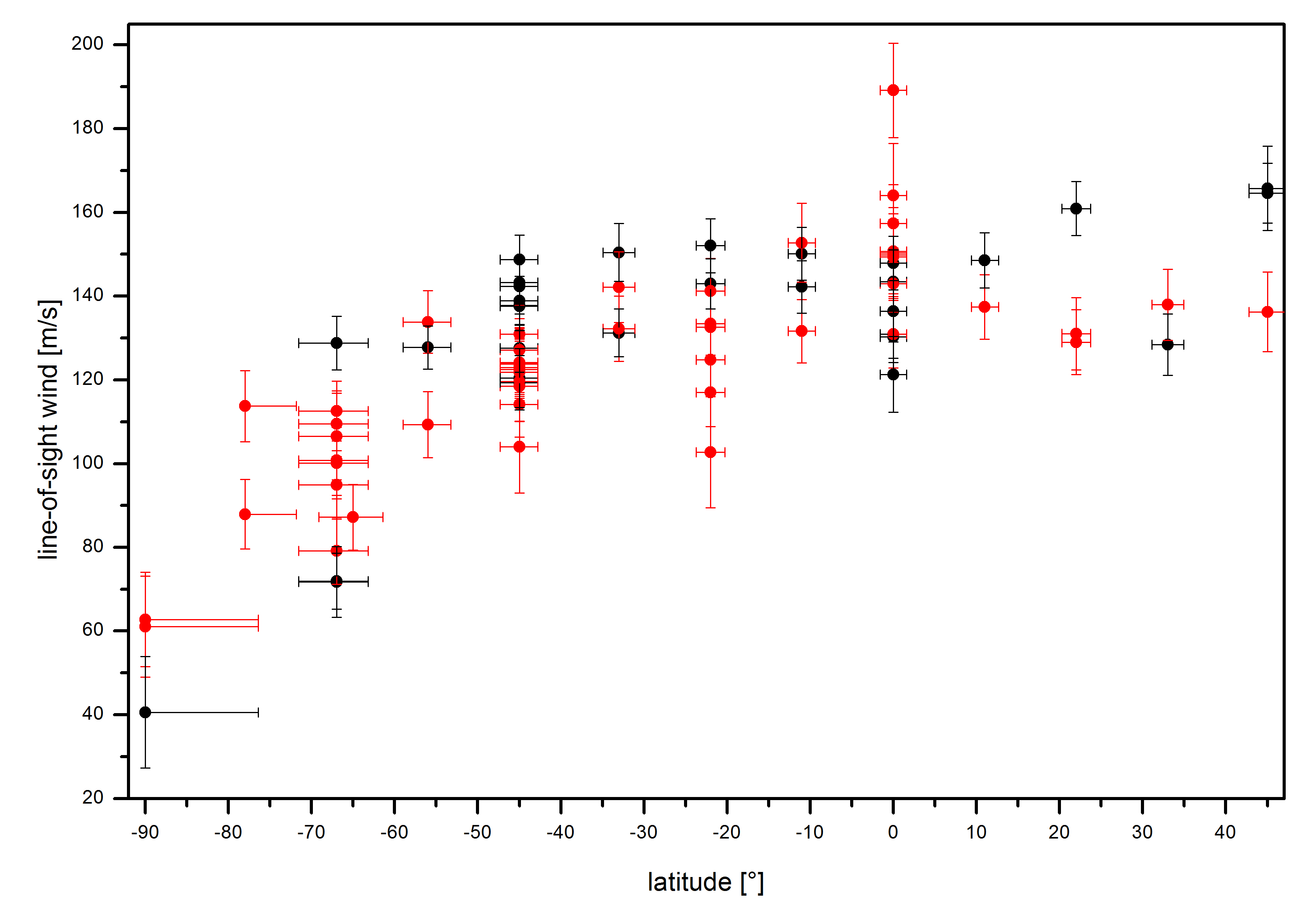
Due to the small line width of the emission features (25MHz FWHM) a high spectral resolution of lambda/delta lambda=106 is required (sornig et al., 2012/sonnabend et al., 2012). The non-LTE CO2 emission line can also be used to determine kinetic temperatures from the line width (Sonnabend et al., 2012). The information is coming from a very small pressure level at the 1 µbar. This corresponds to an altitude level around 110±10 km and 80±10 km on Venus and Mars, respectively(López-Valverde et al., 2011).
Ground-based heterodyne spectroscopy can also be used to observe temperatures on the night side of Venus or Mars probing pressure broadened CO2 absorption lines. From the pressure induced line broadening, the predominant temperature at different altitude layers can be deduced within a pressure region of about 100 to 0.1 mbar (Strangier et al., 2014).
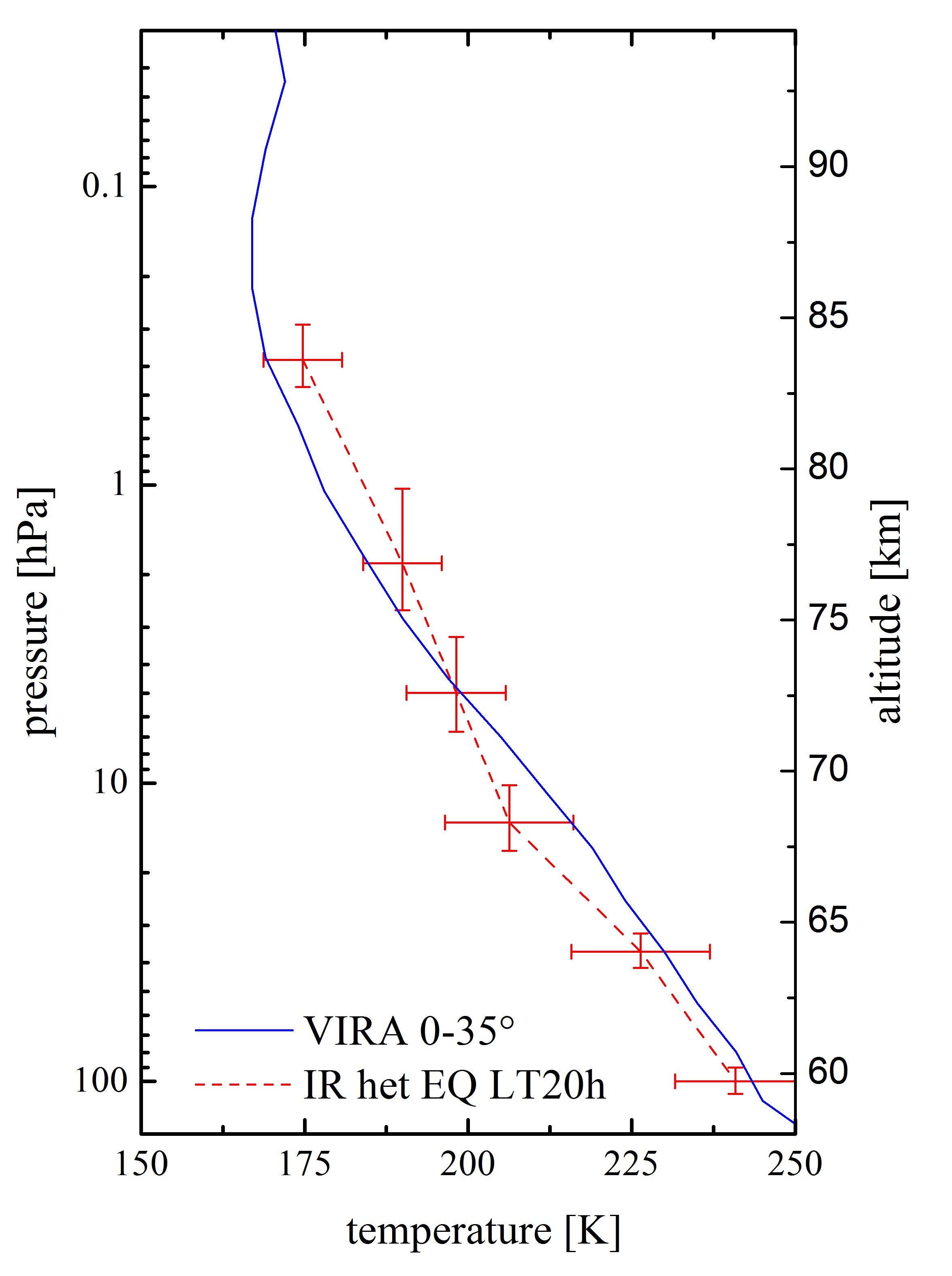
Studies of the composition of planetary atmospheres is another scientific subject which can be addressed by IR heterodyne spectroscopy. Most important are long-term monitoring or spatially resolved observations which usually cannot be accomplished by space missions. In recent years the mid-IR heterodyne technique was used to study, the ozone cycle on Mars (Fast KE et al., 2006) as well as the distribution of Ethane in Titan’s atmosphere before and during the insertion of the Huygens probe (Kostiuk et al., 2005). Most of the observations to-date have been performed using a CO2 laser as LO. Without this limitation THIS and iCHIPS open a new range of molecules for detection at heterodyne resolution including CH4, C2H2 or H2. One ongoing project is to investigate the origin of the unexplained long-term variation of SO2 in Venus’ atmosphere. Detection of SO2 at 8.6 µm with THIS shall contribute to answer this question.
Not least the Earth’s atmosphere offers a wide field of application. Many trace gases have signatures in the mid-IR wavelength regime and can be studied with a transportable ground-based high-resolution spectrometer. Dynamical information can be deduces and sophisticated retrieval algorithms allow deduction of vertical concentration profiles up to 100km altitude from a single fully resolved molecular line (Koide et al., 1995).
In addition to the planetary science addressable with THIS, IR heterodyne spectroscopy can be used to study the interstellar medium or stellar atmospheres, including the Sun. In Sonnabend et al. (2006) for example we showed that high-resolution spectra of molecules in sunspots offer a valuable insight into processes in the solar photosphere. Similar observations will be carried out in stellar atmospheres in the future. And the next generation of large telescopes might even allow studies of proto-planetary discs or exoplanets.
Instruments:
THIS – Tuneable Heterodyne Infrared Spectrometer (Sonnabend et al., 2008)
| Bandwidth | 3 GHz |
| max. spectral resolution | 107 |
| Spectral stability | 1 MHz |
| Wavelength region | 1-13 µm |
| Receiver noise temperature | below 3000K at 10 µm |
| allan time |
10 s |
| Receiver dimensions | 80x80x45 cm3, ~ 80 kg |
iCHIPS -Infrared Compact Heterodyne Instrument for Planetary Science (Stangier et al., 2013)
| Bandwidth (staring mode) |
1.4 GHz |
| Bandwidth (scanning mode) |
150 GHz |
| max. spectral resolution (staring mode) |
107 |
| max. spectral resolution (scanning mode) |
105 |
| Spectral stability (staring mode) |
1 MHz |
| Wavelength region | 7-11 µm |
| Receiver noise temperature | 4000K at 7.8 µm |
| allan time |
10 s |
| Receiver dimensions | 60x42x35 cm3, 36 kg |
Other infrared heerodyn instruments for planetary applications: